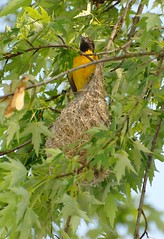Most Baltimore Orioles spend the winter in Florida as well as Central and South America. Their journey north begins at the end of April. By early May, male orioles should reach their breeding grounds in the northern United States.
You can watch their migration at the Journey North website.
Baltimore Oriole Icterus galbula
Order: PASSERIFORMES Family: Blackbirds and Orioles (Icteridae)
Description:
The Baltimore Oriole (7-8.25”) is bright orange bird with black hood and back. Wings are black with orange shoulder patches and strongly white-edged feathers that appear as bars. Female has an olive brown back, yellow/orange underparts and white-edged feathers on the wings. Juvenile is paler overall and has gray belly and the first year male has black throat patch.
General:
The name “oriole” is from the Latin aureolus, which means golden. The Baltimore Oriole was named in the early 1600s for George Calvert, Baron of Baltimore, whose livery stable was painted bright yellow and black. The Baltimore Oriole’s range overlaps with that of the similar Bullock's Oriole in the Midwest, and the two species are sometimes considered to be conspecific (belonging to the same species) under the name Northern Oriole because they form fertile hybrids.
 Image by ben_long_hair via Flickr
Image by ben_long_hair via FlickrOrioles usually stay hidden in the trees eating insect and fruit and singing their beautiful whistling notes. They can be drawn down from their perches with foods like orange slices, grape jelly, mealworms, suet, and nectar feeders.
The Baltimore Oriole is a common inhabitant of suburban landscapes due to is preference for open settings that are bordered with mature trees used for nesting. The Oriole’s hanging-basket nest is an engineering masterpiece woven with plant fibers, grasses, vine and tree bark and sometimes string or yarn 6-45 feet in the air. This keeps them safe from most predators. The female builds her nest and incubates the eggs with little or no help from its mate, but both feed the young. Orioles will lay 4-5 eggs anywhere from May to June and the young will fledge as late as 30 days from egg laying.
Category ›
Bird of the week
 Unknown
Unknown
 Sunday, April 10, 2011
Sunday, April 10, 2011












No comments:
Post a Comment